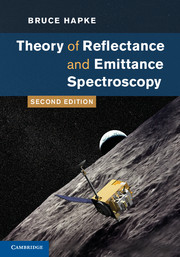Book contents
- Frontmatter
- Contents
- Acknowledgments
- 1 Introduction
- 2 Electromagnetic wave propagation
- 3 The absorption of light
- 4 Specular reflection
- 5 Single-particle scattering: perfect spheres
- 6 Single-particle scattering: irregular particles
- 7 Propagation in a nonuniform medium: the equation of radiative transfer
- 8 The bidirectional reflectance of a semi-infinite medium
- 9 The opposition effect
- 10 A miscellany of bidirectional reflectances and related quantities
- 11 Integrated reflectances and planetary photometry
- 12 Photometric effects of large-scale roughness
- 13 Polarization of light scattered by a particulate medium
- 14 Reflectance spectroscopy
- 15 Thermal emission and emittance spectroscopy
- 16 Simultaneous transport of energy by radiation and thermal conduction
- Appendix A A brief review of vector calculus
- Appendix B Functions of a complex variable
- Appendix C The wave equation in spherical coordinates
- Appendix D Fraunhofer diffraction by a circular hole
- Appendix E Table of symbols
- Bibliography
- Index
5 - Single-particle scattering: perfect spheres
Published online by Cambridge University Press: 05 January 2012
- Frontmatter
- Contents
- Acknowledgments
- 1 Introduction
- 2 Electromagnetic wave propagation
- 3 The absorption of light
- 4 Specular reflection
- 5 Single-particle scattering: perfect spheres
- 6 Single-particle scattering: irregular particles
- 7 Propagation in a nonuniform medium: the equation of radiative transfer
- 8 The bidirectional reflectance of a semi-infinite medium
- 9 The opposition effect
- 10 A miscellany of bidirectional reflectances and related quantities
- 11 Integrated reflectances and planetary photometry
- 12 Photometric effects of large-scale roughness
- 13 Polarization of light scattered by a particulate medium
- 14 Reflectance spectroscopy
- 15 Thermal emission and emittance spectroscopy
- 16 Simultaneous transport of energy by radiation and thermal conduction
- Appendix A A brief review of vector calculus
- Appendix B Functions of a complex variable
- Appendix C The wave equation in spherical coordinates
- Appendix D Fraunhofer diffraction by a circular hole
- Appendix E Table of symbols
- Bibliography
- Index
Summary
Introduction
One of the fundamental interactions of electromagnetic radiation with a particulate medium is scattering by individual particles, and many of the properties of the light diffusely reflected from a particulate surface can be understood, at least qualitatively, in terms of single-particle scattering. This chapter considers scattering by a sphere. Although perfectly spherical particles are rarely encountered in the laboratory and never in planetary soils, they are found in nature in clouds composed of liquid droplets. For this reason alone, spheres are worth discussing. Even more important, however, is the fact that a sphere is the simplest three-dimensional object whose interaction with a plane electromagnetic wave can be calculated by exact solution of Maxwell's equations. Therefore, in developing various approximate methods for handling scattering by nonuniform, nonspherical particles, the insights afforded by uniform spheres are invaluable.
In the first part of this chapter some of the quantities in general use in treatments of diffuse scattering are defined. Next, the theory of scattering by a spherical particle is described qualitatively, and conclusions from the theory are discussed in detail. Finally, an analytic approximation to the scattering efficiency that is valid when the radius is large compared with the wavelength is derived.
Concepts and definitions
Radiance
In a radiation field where the light is uncollimated, the amount of power at position r crossing unit area perpendicular to the direction of propagation Ω, traveling into unit solid angle about Ω, is called the radiance and will be denoted by I (r, Ω). Radiance is often also called specific intensity, or simply intensity, or brightness.
- Type
- Chapter
- Information
- Theory of Reflectance and Emittance Spectroscopy , pp. 66 - 99Publisher: Cambridge University PressPrint publication year: 2012
- 1
- Cited by



